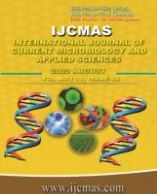


 National Academy of Agricultural Sciences (NAAS)
National Academy of Agricultural Sciences (NAAS)

|
PRINT ISSN : 2319-7692
Online ISSN : 2319-7706 Issues : 12 per year Publisher : Excellent Publishers Email : editorijcmas@gmail.com / submit@ijcmas.com Editor-in-chief: Dr.M.Prakash Index Copernicus ICV 2018: 95.39 NAAS RATING 2020: 5.38 |
Fruits and vegetables are very significant and have high dietary and nutritional qualities. Ingesting of fruit and vegetable products has histrionically augmented by more than 40 % during the former few decades. India is the fourth major producer of fruits and second foremost producer of vegetables in the world. Most vegetables and fruits have a derisory life and are further vulnerable to spoilage. Besides enzyme degradation, rancidity and oxidation being the roots of spoilage, the other main reason being the spoilage caused by microorganisms such as bacteria, fungi and Yeasts. This is making 30 % of the produce go into rejection. Reduction in the losses of vegetables and fruits leads to various positive outcomes which can be achieved by the assessment of spoilage of causing microorganisms and their preventive measures. The present research study aimed to explore the microbes in different spoiled fruits and vegetables. Bacillus sp. (18 %) was found to be the predominant species inhabiting most of the vegetables and fruits and Penicillium sp. (35 %) being the predominant species in case of fungi. The utmost prerequisite is the identification of the comprehensive deteriorative microorganisms for diverse kinds of fresh fruits and vegetables stored under exclusive packaging situations. In arrears to the rising awareness, there is also an inevitability for research of spoilage arrays and micro flora of vegetables and fruits commodity packaged with innovative and evolving to safeguard care while preserving the sensory, nutritional properties and to avoid rejections.
 |
 |
 |
 |
 |